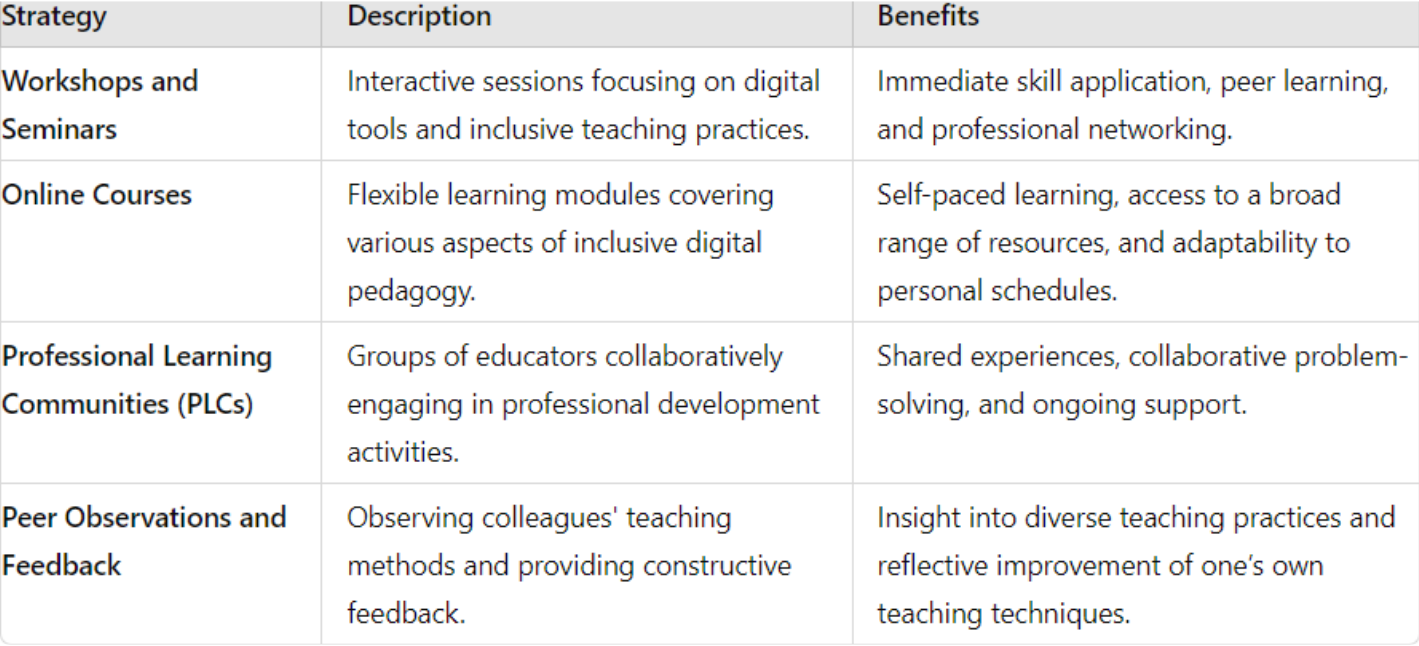Empowering Educators: Continuous Development for Inclusive Digital Pedagogy
Materials
1. Introduction
Continuous Professional Development (CPD) refers to the process of tracking and documenting the skills, knowledge, and experience that educators gain as they work, both formally and informally. This encompasses all forms of learning and development activities, whether undertaken individually or collectively, structured or unstructured. The ultimate goal of CPD is to ensure that educators remain competent and effective in their professional roles.
CPD is crucial for educators as it promotes lifelong learning and helps them keep pace with the evolving educational landscape. In the context of inclusive digital pedagogy, CPD becomes even more significant. It ensures that educators are equipped with the necessary skills and knowledge to effectively integrate digital tools into their teaching practices while catering to the diverse needs of their students.
2. Importance of CPD in Inclusive Digital Pedagogy
Inclusive digital pedagogy aims to create a learning environment that accommodates all students, regardless of their backgrounds, abilities, or learning styles. This approach recognizes the diverse needs of students and strives to provide equitable access to education. CPD plays a vital role in achieving this by enabling educators to:
- Stay Updated with Educational Technologies: The rapid advancement of technology necessitates continuous learning. CPD helps educators stay abreast of the latest digital tools and platforms that can enhance teaching and learning experiences.
- Develop Skills for Creating Inclusive Learning Environments: CPD provides educators with strategies and methodologies to create inclusive classrooms where every student feels valued and supported.
- Enhance Teaching Strategies: Through CPD, educators can learn new instructional techniques and approaches that cater to the diverse learning needs of their students, thereby improving student engagement and achievement.
3. CPD Strategies for Inclusive Digital Pedagogy
Table 1: CPD Strategies and Their Benefits

3.1 Principles of Inclusivity in Education
Inclusivity in education is rooted in the recognition and accommodation of the diverse ways individuals learn and interact with information. Key principles include:
Equity and Access: Ensuring all students have equal access to learning materials, resources, and opportunities, thereby reducing barriers that may hinder participation and achievement.
Cultural Competence: Acknowledging and valuing the cultural backgrounds and experiences of all students, integrating these perspectives into the curriculum and learning activities.
Differentiated Instruction: Adapting teaching methods to meet the varied learning needs, styles, and paces of students, ensuring that each individual can engage with the material in the most effective way.
Universal Design for Learning (UDL): Implementing a flexible learning environment that can accommodate individual learning differences through multiple means of representation, expression, and engagement.
4. Implementing CPD: A Step-by-Step Guide
4.1 Assess Needs
- Identify Areas for Development: Use student feedback, self-assessment, and peer evaluations to pinpoint areas where improvement is needed.
- Prioritize Skills and Knowledge: Focus on developing skills and knowledge that will enhance your ability to implement inclusive digital pedagogy.
4.2 Set Goals
- Define Clear Objectives: Establish specific, measurable, achievable, relevant, and time-bound (SMART) goals for your professional development.
- Align with Career and Institutional Goals: Ensure your CPD goals align with your personal career aspirations and the broader objectives of your institution.
4.3 Create a Development Plan
- Plan Specific Activities: Identify and schedule CPD activities, such as attending workshops, enrolling in online courses, or participating in professional learning communities.
- Timeline Management: Organize these activities over a manageable timeline to prevent overload and ensure consistent progress
4.4 Engage in CPD Activities
- Active Participation: Take an active role in the CPD activities you have planned.
- Apply New Skills: Implement the new knowledge and skills you acquire in your teaching practice to improve your inclusivity and effectiveness.
4.5 Engage in CPD Activities
- Reflect on Learning: Consider what you have learned from your CPD activities and how it impacts your teaching.
- Seek Feedback: Gather feedback from peers and students to assess the effectiveness of your new strategies and identify further areas for improvement.
4.6 Engage in CPD Activities
- Keep Records: Maintain a detailed record of all CPD activities and their outcomes.
- Share Insights: Share your experiences and insights with colleagues to contribute to a culture of continuous improvement within your educational community.
5. Benefits of CPD for Educators and Students
For Educators:
- Enhanced Skills: CPD enables educators to continuously develop new teaching strategies and technological skills, keeping their practice relevant and effective.
- Professional Growth: Regular engagement in CPD activities contributes to career advancement, professional recognition, and increased job satisfaction.
- Adaptability: By staying updated with the latest educational trends and technologies, educators become more adaptable to changes and challenges in the education landscape.
For Students:
- Improved Learning Experience: Educators who engage in CPD are better equipped to create engaging and effective learning environments, which can lead to improved student motivation and achievement.
- Inclusivity: Teachers trained in inclusive pedagogy can better address the diverse learning needs of their students, ensuring that all students have equitable access to education.
- Higher Achievement: Quality teaching, supported by ongoing professional development, directly impacts student success and academic achievement, leading to better overall outcomes for students.
6. Conclusion
Continuous Professional Development (CPD) is an essential component for educators striving to excel in inclusive digital pedagogy. By engaging in regular CPD activities, educators not only enhance their professional skills but also contribute significantly to student success. CPD provides a structured approach to learning that enables educators to stay current with the latest educational trends, technologies, and pedagogical strategies. This ongoing development is particularly critical in the realm of digital pedagogy, where rapid technological advancements require educators to continuously update their knowledge and skills (Geldenhuys & Oosthuizen, 2015).
A well-implemented CPD program fosters a culture of continuous learning and improvement within educational institutions. This culture encourages educators to be lifelong learners, modeling the behavior they wish to see in their students. By participating in CPD, educators can collaborate with peers, share best practices, and reflect on their teaching methods, leading to a more dynamic and effective learning environment (Knight, 2010).
Moreover, CPD has a direct impact on student outcomes. Educators who are well-versed in inclusive digital pedagogy are better equipped to create engaging and accessible learning experiences for all students, including those with diverse learning needs. This inclusivity ensures that all students have equal opportunities to succeed, thereby promoting equity in education (Hauge & Wan, 2019).
In addition to enhancing teaching practices, CPD also boosts teacher confidence and morale. When educators feel competent and supported in their professional growth, they are more likely to exhibit a positive attitude toward teaching and embrace innovative instructional strategies. This positivity and willingness to innovate can significantly enhance the overall educational experience for students (Hubbard, 2018).
Educational institutions that prioritize CPD can expect to see numerous benefits, including improved teacher retention rates, higher levels of student achievement, and a more inclusive school culture. As educators become more proficient in using digital tools and inclusive practices, they can better meet the diverse needs of their students, creating a more equitable and effective educational environment (Kohnke, 2021).
In conclusion, Continuous Professional Development is not just an optional add-on for educators; it is a fundamental necessity. By fostering a commitment to lifelong learning and continuous improvement, CPD empowers educators to deliver high-quality, inclusive digital education. This commitment ultimately leads to enhanced student outcomes and a more equitable and effective teaching environment, ensuring that all students can thrive in the digital age.
References
Desimone, L. M. (2009). Improving impact studies of teachers’ professional development: Toward better conceptualizations and measures. Educational Researcher, 38(3), 181-199. https://doi.org/10.3102/0013189X08331140
Geldenhuys, J. L., & Oosthuizen, L. C. (2015). Challenges influencing teachers’ involvement in continuous professional development: A South African perspective. Teaching and Teacher Education, 5, 203–212.
Guskey, T. R. (2002). Professional development and teacher change. Teachers and Teaching, 8(3), 381-391. https://doi.org/10.1080/135406002100000512
Hauge, K., & Wan, P. (2019). Teachers’ collective professional development in school: A review study. Cogent Education, 6(1), 1619223.
Hubbard, P. (2018). Technology and professional development. Wiley.
Knight, J. (2010). Unmistakable impact: A partnership approach to dramatically improving instruction. SAGE.
Kohnke, L. (2021). Professional Development and ICT: English Language Teachers’ Voices. Online Learning Journal, 25(2), 36–53.
Knight, P. (2002). A systematic approach to professional development: Learning as practice. Teaching and Teacher Education, 18(3), 229-241. https://doi.org/10.1016/S0742-051X(01)00066-3
Mishra, P., & Koehler, M. J. (2006). Technological Pedagogical Content Knowledge: A framework for integrating technology in teachers’ knowledge. Teachers College Record, 108(6), 1017-1054. https://doi.org/10.1111/j.1467-9620.2006.00684.x
4. Continuous Professional Development Addition
Continuous Professional Development for Inclusive Digital Teaching
10 min
Understand the importance of Continuous Professional Development for Inclusive Digital Teaching.
Continuous Professional, Empowering Educators, Education








Funded by the European Union. Views and opinions expressed are however those of the author(s) only and do not necessarily reflect those of the European Union or the European Education and Culture Executive Agency (EACEA). Neither the European Union nor EACEA can be held responsible for them (2022- 1 -SI01 -KA220-HED-000088368).






